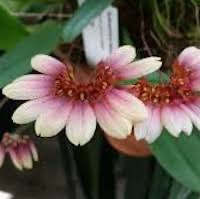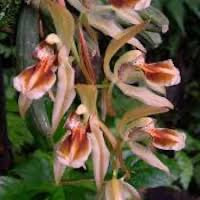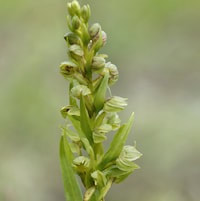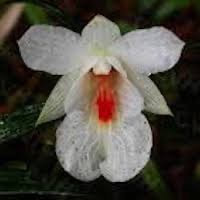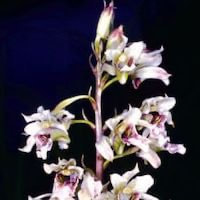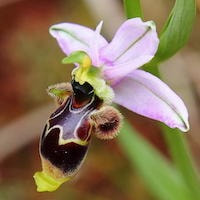WFR12- Women's Fresh 12 - Its Raining men
|
Native Singaporean Orchid notes: Sophrolaeliocattleya Mahalo Jack
Sophrolaeliocattleya Mahalo Jack, a hybrid orchid from Att walkeriana and Sl Orpetii, features compact growth and vibrant deep magenta to purple flowers adorned with golden accents. Known for its alluring fragrance and striking appearance, it is selected for the Fresh 12 (Women) perfume workshop at Scentopia to enhance team building through its aromatic and visually appealing qualities.
|
Therapeutic Orchid notes:
|
Bulbophyllum flabellum-veneris Syn. Bulbophyllum lepidum (Blume) J.J. Sm., Cirrhopetalum lepidum (Blume) Schltr.
Bulbophyllum flabellum-veneris, also called Bulbophyllum lepidum or Cirrhopetalum lepidum, is a Southeast Asian orchid with olive-green flowers blooming year-round, peaking in monsoon seasons. In Thailand, its pseudobulb treats edema, reducing fluid buildup, and the whole plant is used for liver issues. Locally known as Phet phra in, Sa mai, and Khon dam phi, it holds medicinal value in Thai culture. This orchid's widespread use reflects its traditional role in treating health conditions, highlighting its importance. |
|
Coelogyne fuscescens Lindl.
Coelogyne fuscescens, known as Hechunbeimu Lan in Chinese and by Thai names Sing to, phaya rat, and phao hin, is an orchid species valued for its medicinal properties across Southeast Asia. In Thailand, it is considered an aphrodisiac, potentially enhancing sexual desire. Its stems are used in treating burns and ear inflammation (otitis media). In Nepal, the orchid's juice relieves abdominal pain, and poultices ease discomfort. These uses demonstrate the orchid's cultural importance and diverse medicinal applications in regional traditional medicine practices. |
|
Dactylorhiza viridis (Linn.) R.M. Bateman, Pridgeon and M.W. Chase syn. Coeloglossum viride Hartm.
Dactylorhiza viridis, also known as Woshe Lan in Chinese and the frog orchid in Alaska, is a hardy winter orchid species capable of surviving extreme cold and dry conditions. Phytochemical analysis suggests it may have neuroprotective properties. Related orchids like Dactylorhiza hatagirea have shown aphrodisiac effects in rats, increasing their attraction to females. In various cultures, including Singapore, southern Asia, Iran, Turkey, and Georgia, Dactylorhiza orchids are used in supplements for their revitalizing and aphrodisiac qualities, reflecting their perceived health benefits across different regions. |
|
Dendrobium sinense T. Tang & F.T. Wang
Dendrobium sinense, also known as Hua shihu or Chinese Dendrobium, is an orchid species valued in traditional medicine for its health benefits. It contains compounds like denbinobin B, which has antibacterial effects against Staphylococcus aureus. Three phenanthrenes isolated from the plant also show mild cytotoxicity. In herbal medicine, Dendrobium sinense is used whole as shihu, known for treating various health issues and contributing to traditional medicinal practices. |
|
Eulophia bicallosa (D. Don) P.F.Hunt & Summerh.
Eulophia bicallosa, also known as Taiwan Meiguan Lan or Taiwan beautiful crown orchid, is widely found across Japan, Taiwan, and several Chinese provinces. It's also referred to as Lianchiyangersuan in Chinese and Yukoku-ran in Japanese. This orchid is prized in traditional Chinese medicine for its healing properties. The entire plant is used to boost vital energy and blood, treat conditions like tuberculosis, sores, and abdominal pain, and act as an antipyretic and antidote. Its use reflects its role in promoting overall health and treating various ailments. |
|
Ophrys scolopax Cav.
Ophrys scolopax, also known as Salep orchid, is a small to medium-sized herb found in cold climates. It blooms from March to June across regions from Hungary to northern Iran, including the Mediterranean and North African countries. The orchid's tubers are particularly valuable for their medicinal uses. They are harvested to produce Salep, a substance renowned for its soothing and nourishing qualities. Salep has been used in traditional medicine for its potential health benefits, making it a significant component in herbal remedies worldwide. |
Other scent note
Scentopia Library Reference ingredient
River Peppermint- Sentosa's plants - Check details at Scentopia's scent library
Download the guided mediation that works best with this Orchid fragrance oil
| women_fresh_essential_oil_orchi_00012.mp3 | |
| File Size: | 114697 kb |
| File Type: | mp3 |

